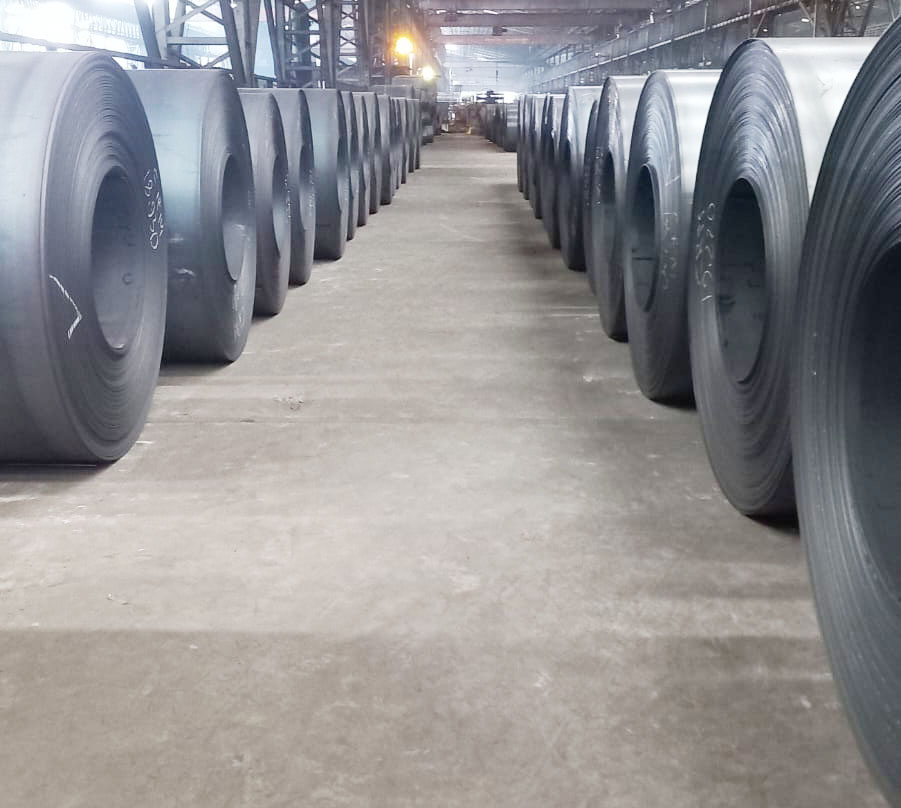Hot-rolled coils (HRC) are a form of sheet product that resembles a wrapped steel strip and are manufactured in hot-rolling mills. These products are commonly used in construction, the machine industry, automobile manufacturing, the manufacture of general-purpose, construction, oil and gas, and special-purpose pipes, and as a work-piece for the subsequent manufacture of cold-rolled items.
Hot-rolled steel coils application
Hot-rolled coil is used to construct steel buildings, pipes, and closed sections, as well as to enclose structures and facade elements. In this industry, shaped and circular pipes are mostly utilized for:
- Steel structures and frames that support industrial and civil facilities
- Enclosures that protect various utility lines (wires and cables, plastic or other channels)
- Main pipelines, water lines, and heat supply networks, as well as bridges and trestles, are all supported.
- Sewer lines, flue ducts, and ventilation systems are all examples of infrastructure.
- Poles, guides, drainage elements, lighting columns, and crash barriers for road construction
- Steel structures for use in sports fields and playgrounds, as fences and partitions, and in other applications.
Minimum dimension tolerances, large coil weight, weldability, high strength and toughness, crack resistance (even at negative temperatures), and external resistance are the major requirements of this segment for this type of rolled product. In the building industry, cold-rolled steel products have recently been supplanted by less expensive, thin hot-rolled goods. High-strength rolled product kinds, on the other hand, are increasingly commonly employed to minimize product weight.
Hot-rolled steel coils for large diameter pipe manufacturing
Spiral seams are used to manufacture large-diameter pipes made of HRC steel. This method enables the manufacture of pipes with diameters of up to 2,520 mm for the following segments:
- Pipelines used to carry oil, gas, and other commodities.
- Process pipes, heat supply networks, water lines, and sewage lines are all examples of pipelines.
- Industrial facility supports, bridges and trestles, onshore and offshore platform elements.
Hot-rolled steel sheet must be in coils weighing up to 32 tonnes for these purposes, allowing for increased equipment capacity and production. HRC should have good weldability, high strength and toughness, and crack resistance (even at negative temperatures). Because of the rising abrasiveness of transported substances, demand for rolled steel with certified resistance to hydrogen sulphide media (HIC, SSC) is increasing. Higher process pressure inside pipelines necessitates the use of thicker-walled pipes constructed of high-strength steel grades such as X60-X100.
Hot-rolled steel coils for re-rolling
In order to produce cold-rolled steel products, a sizeable portion of the world’s HRC steel production is used as a feedstock. Narrow dimensional tolerance limits, plasticity, good surface quality, and the absence of rust and other exterior and internal flaws are important requirements for HRC.
Before cold rolling, rust and other impurities are removed from the surfaces of hot-rolled coils using acid pickling. Orders are placed for hot-rolled products that have already been pickled and/or oiled by cold-rolled coil companies who lack pickling lines or have limited usage for them.
Hot-rolled coils for the machine industry
The following sectors of the machine industry frequently use hot-rolled steel in coil form:
- Heavy engineering and machine tool engineering (machine tool bodies and parts, mining equipment, roads, and handling equipment)
- Automotive engineering (car and truck bodywork, freight wagon liner components, tanks, truck-mounted crane booms, etc.)
- to produce agricultural machinery bodies and its various elements, including ploughs, blades, harrows, and seeding equipment.
By using high-strength, low-alloy rolled steel more frequently (such as dual-phase steels, TMCP steel, etc.), machinery and equipment may lift (carry) more weight and operate more effectively.
Hot-rolled steel coils for service metal centres
Machine engineering companies, shipyards, wind farms, producers of boiler equipment, etc. are some examples of the service metal centers’ final clients. Service metal centers use a large variety of steel product grades and sizes because to the diverse range of applications for steel products. For laser and plasma cutting at fully automated factories, the HRC should have incredibly exact size dimensions, consistent mechanical properties, and low internal tensions.
Hot-rolled steel coils classification
Numerous industries use hot-rolled steel coils, and each of these industries has unique standards for the end products’ quality parameters. The following technical standards for HRC manufacture mostly apply:
European standards include DIN 17100, EN 10083, EN 10120, EN 10025, EN 10028, 10111, and 10149.
Standards for the CIS and Ukraine include DSTU EN 10025, DSTU 2834/GOST 16523, GOST 14637, GOST 1577, DSTU 7808/GOST 4041, GOST 17066, and DSTU 8541/GOST 19281, GOST 8568, and GOST 5521.
American Petroleum Institute (API) standards, ASTM A36/A36M, A1011/A1011M, ASTM A568, and others are examples of US standards.
Production of hot-rolled coils
Hot-rolled coil (wide strip) products are produced by semi-continuous or continuous hot-rolling mills, which can also be a part of compact strip production plants.
Continuously cast or rolled slabs made of carbon, low-alloy and alloy steel grades are used as a semi-finished product to make steel coils. The HRC production process includes the following stages:
- In a reheating furnace, heat the slab prior to rolling (the heating temperature is adjusted based on the steel grade and the chosen production parameters).
- To remove scale from the feedstock’s surface, use a hydraulic descaler.
- Rolling in a coilbox unit’s roughing and finishing stands with or without intermediary rewinding of the semi-finished strip
- Observing the rolled strip’s cooling
- Placing the finished goods on downcoilers for winding
- Hot-rolled steel coils are finished, including by cutting, accepting, packaging, labeling, etc.
Buy hot-rolled steel coils from the manufacturer
Gunung Prisma manufactures hot-rolled coils with a thickness range of 1.2 to 25 mm in compliance with client requests and international standards. Both hot-rolled and specific in-line treatments (such as controlled rolling, thermomechanical rolling, and normalized rolling) are offered for the products. All of Europe, Asia, Africa, and North America can get HRC.
Source:


